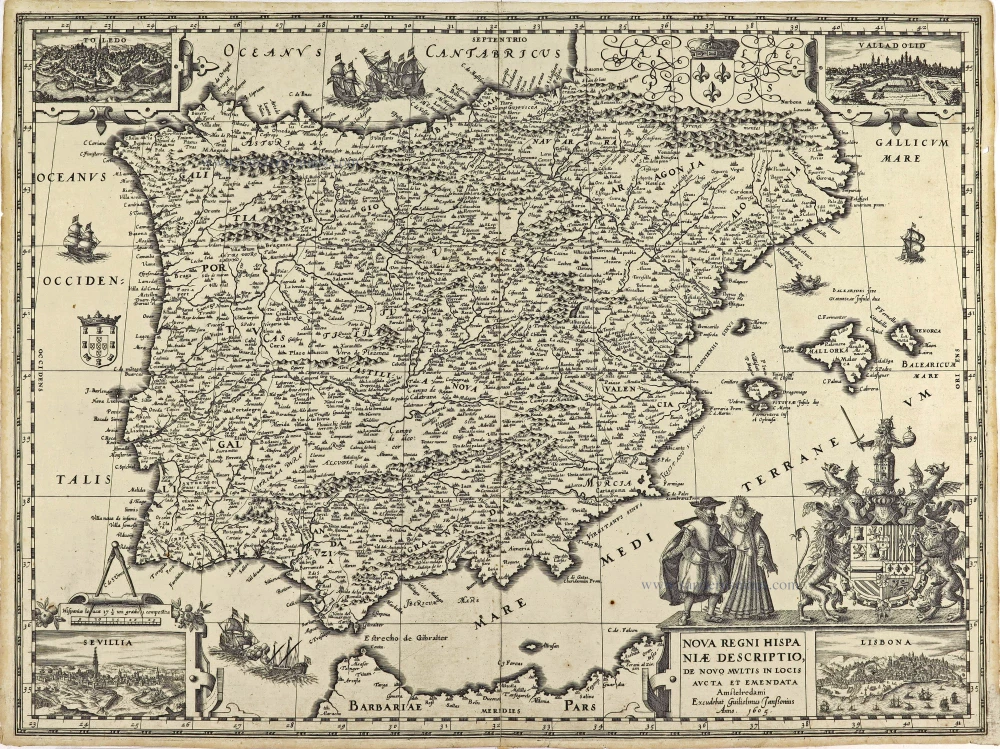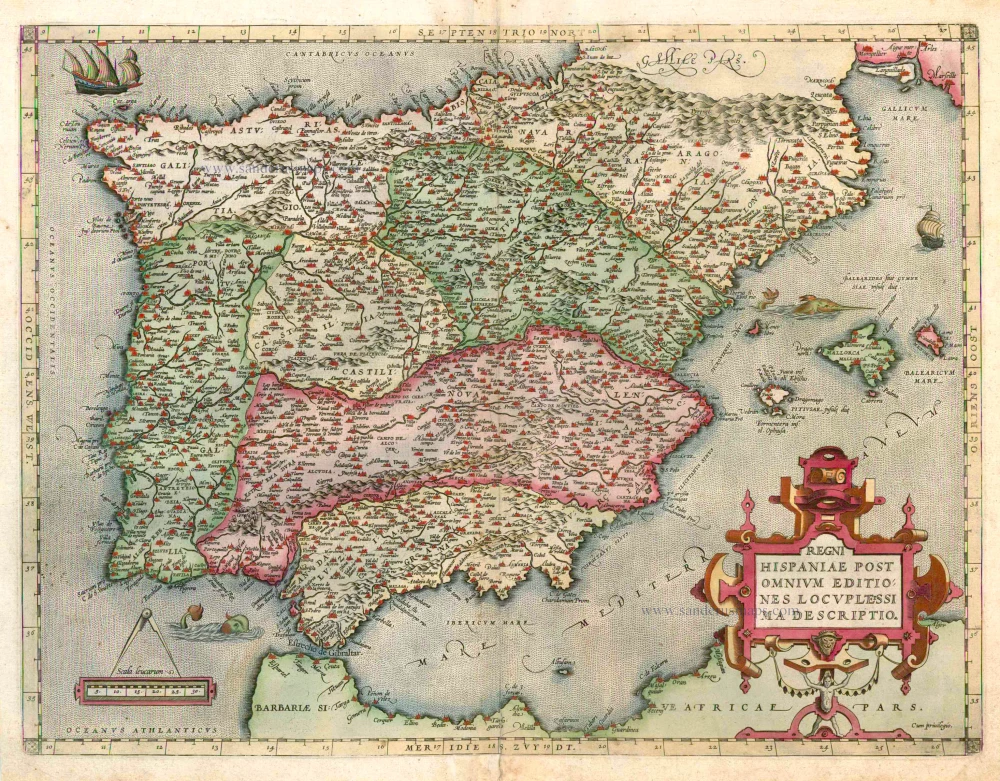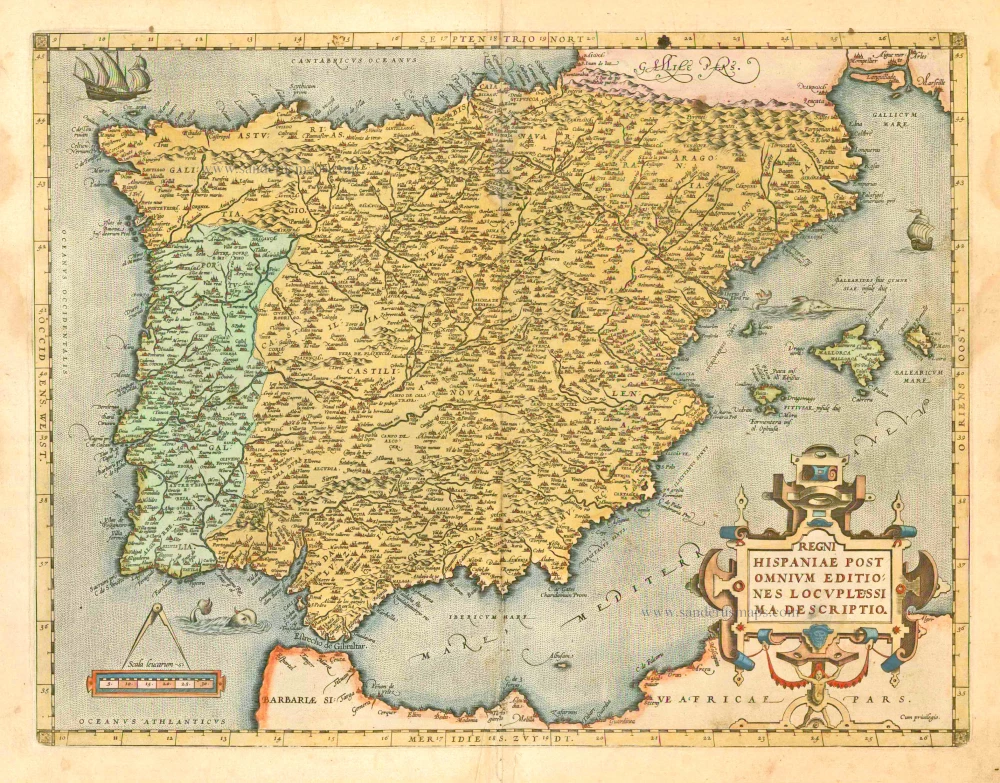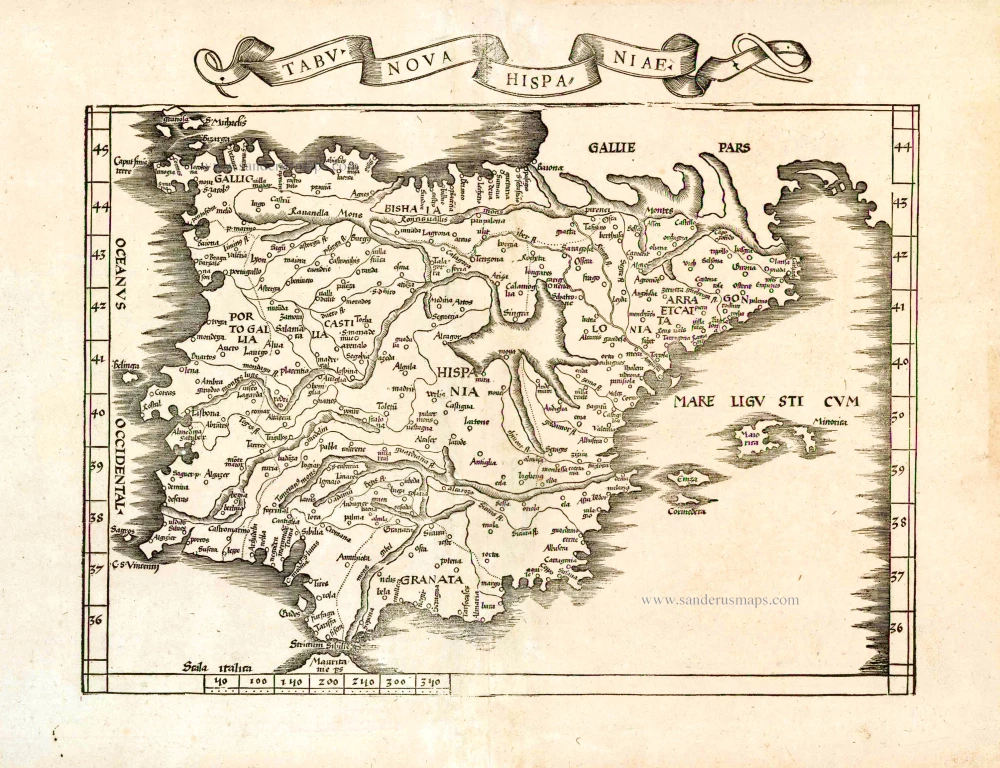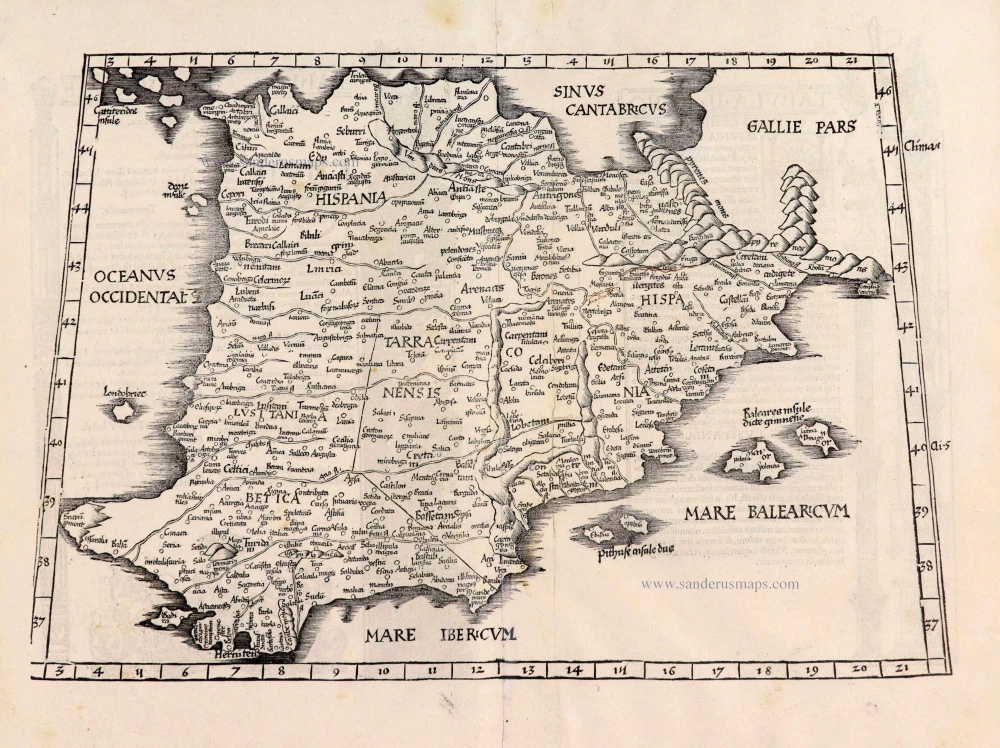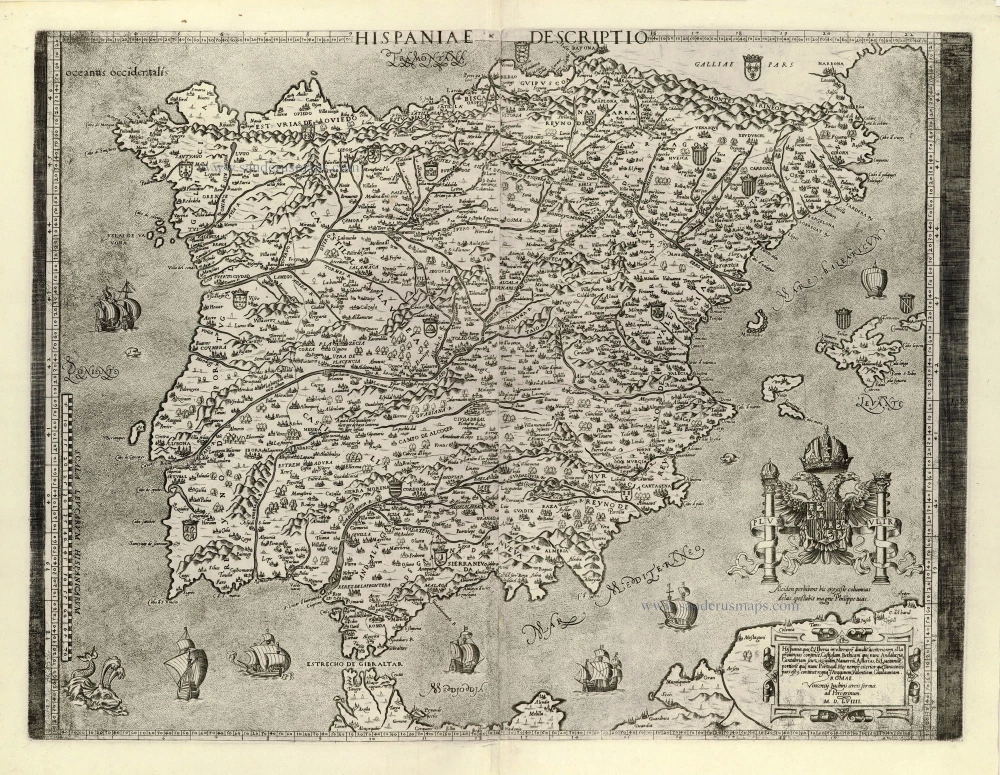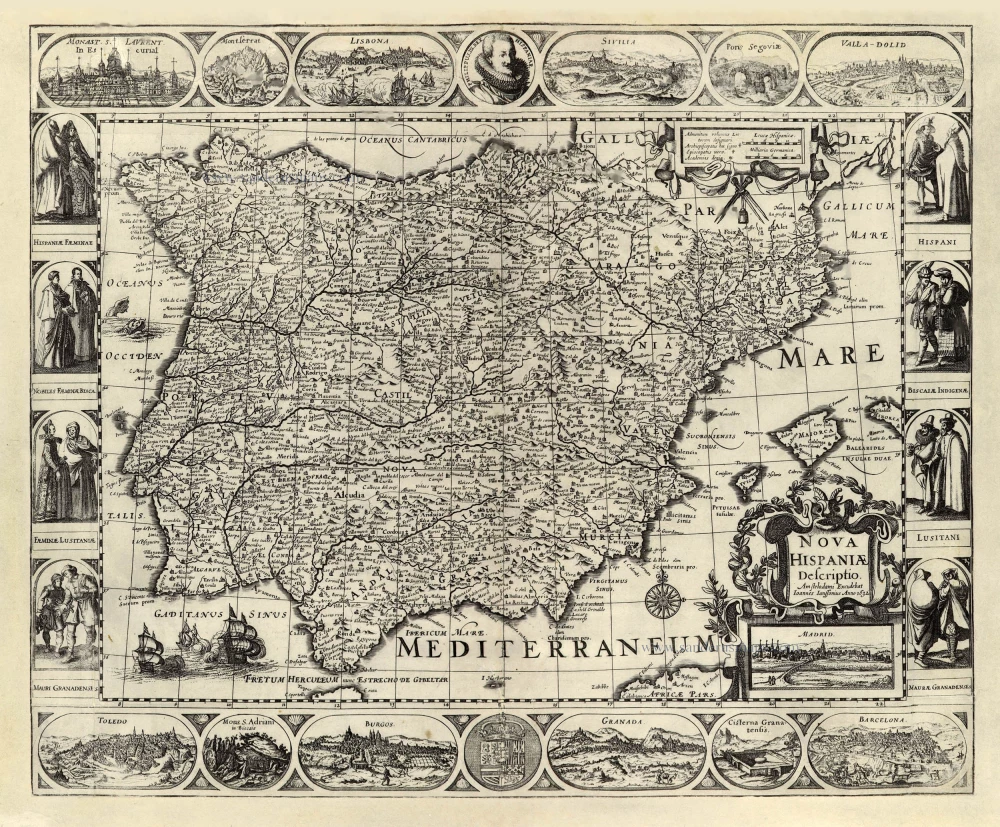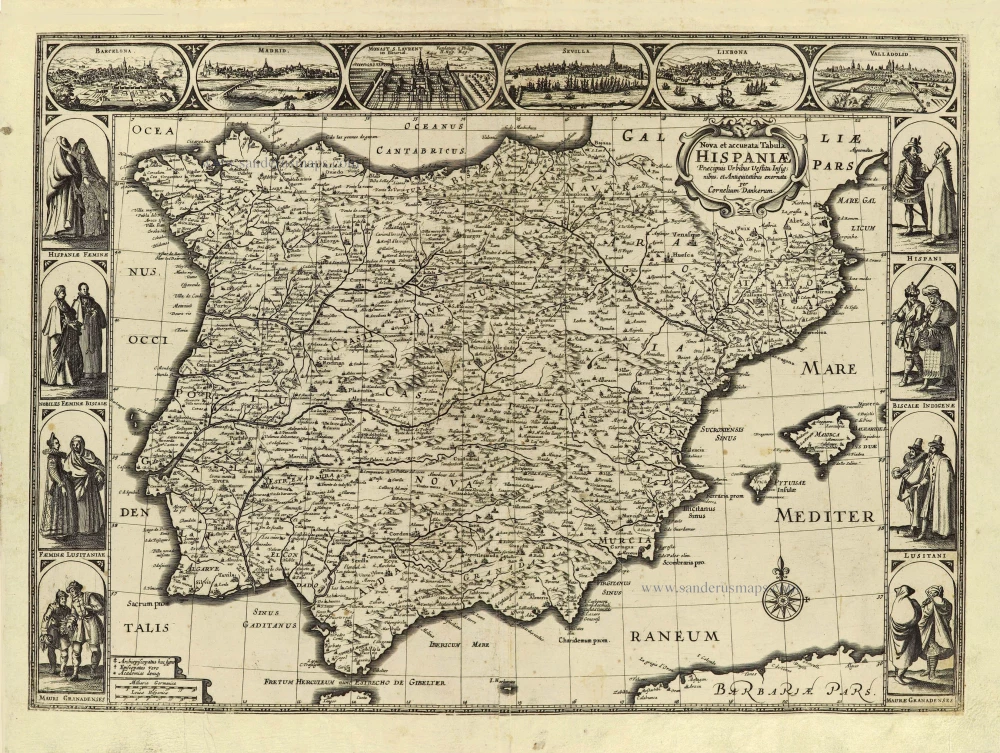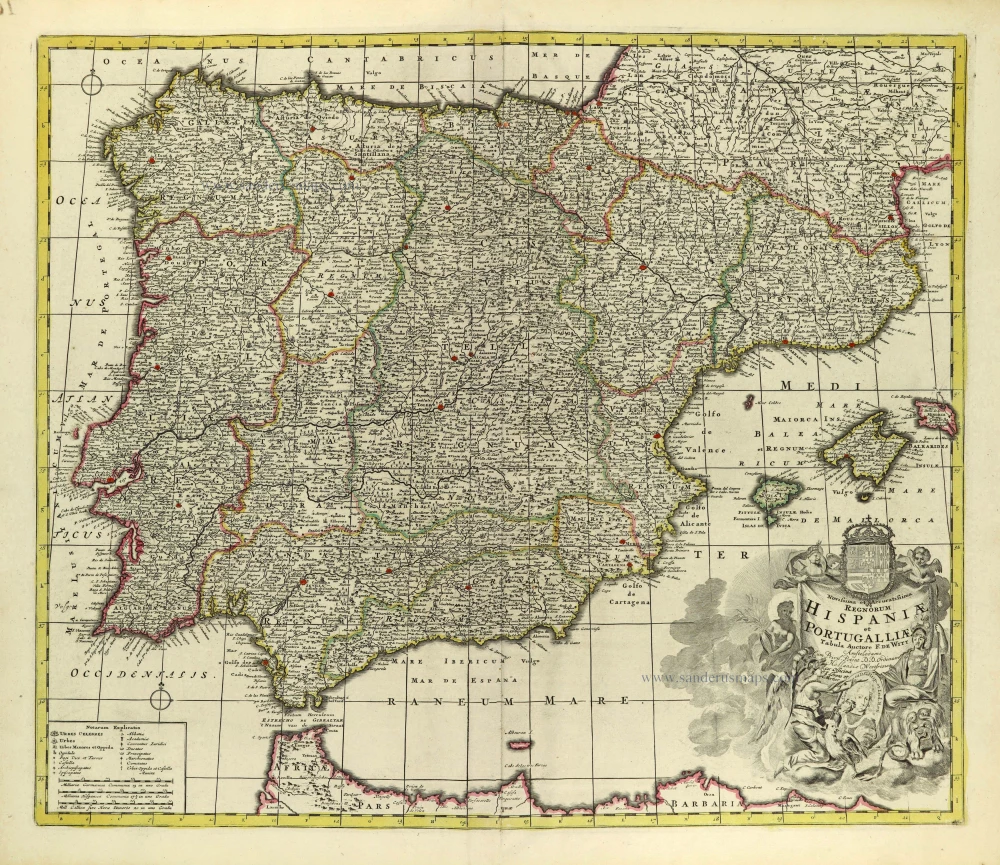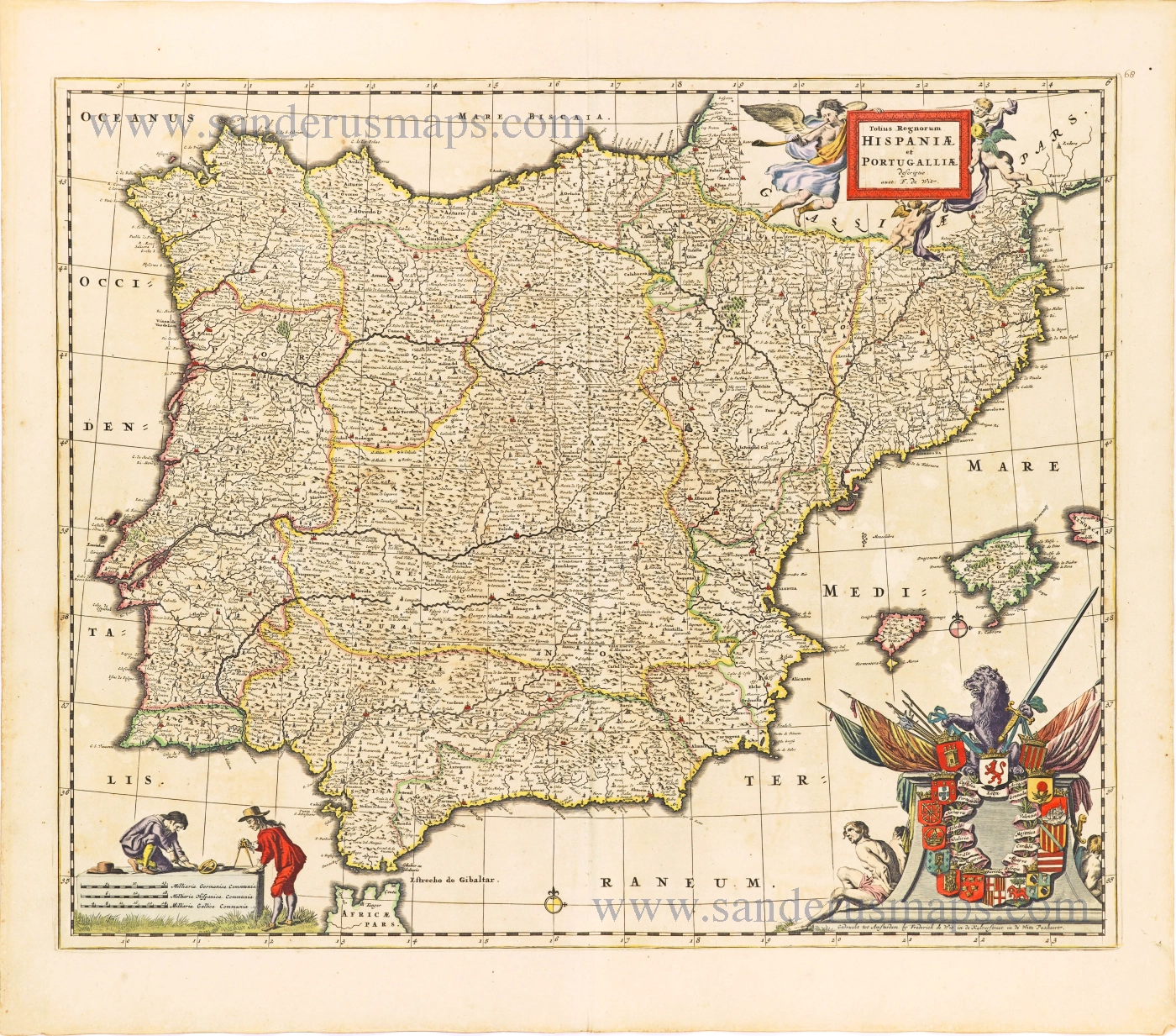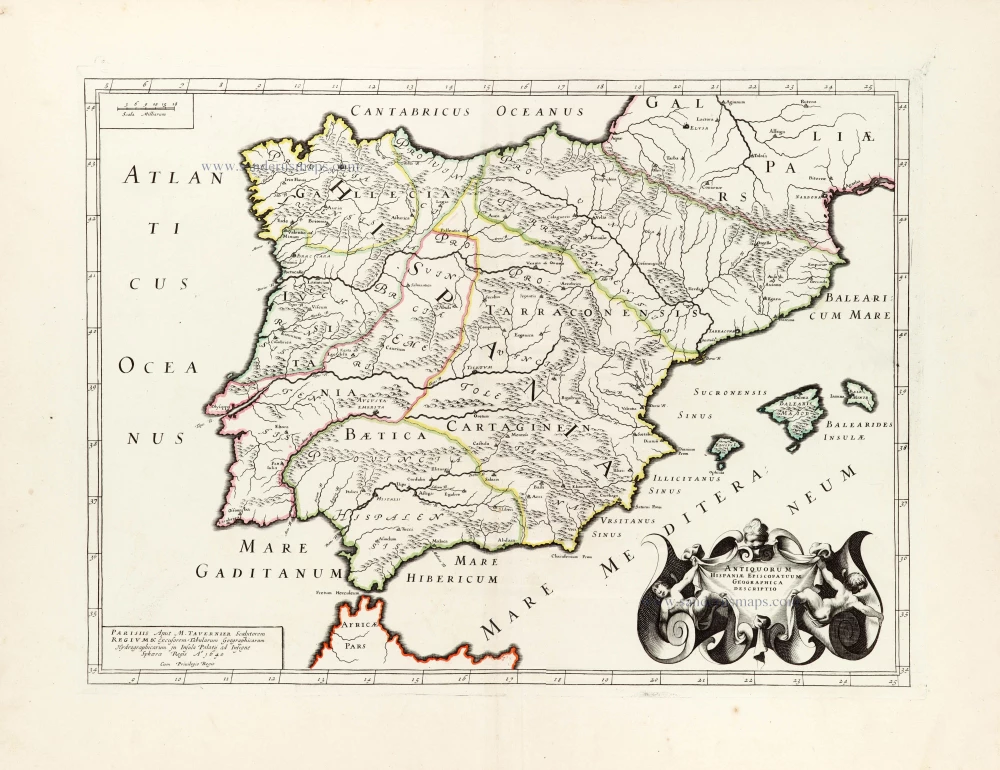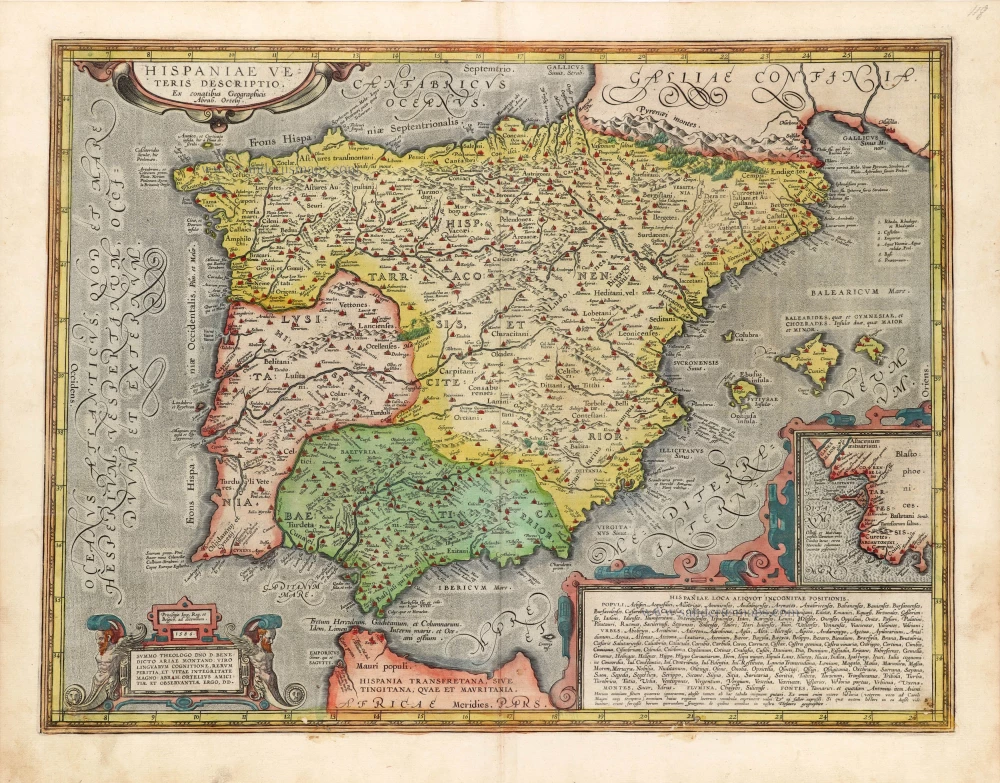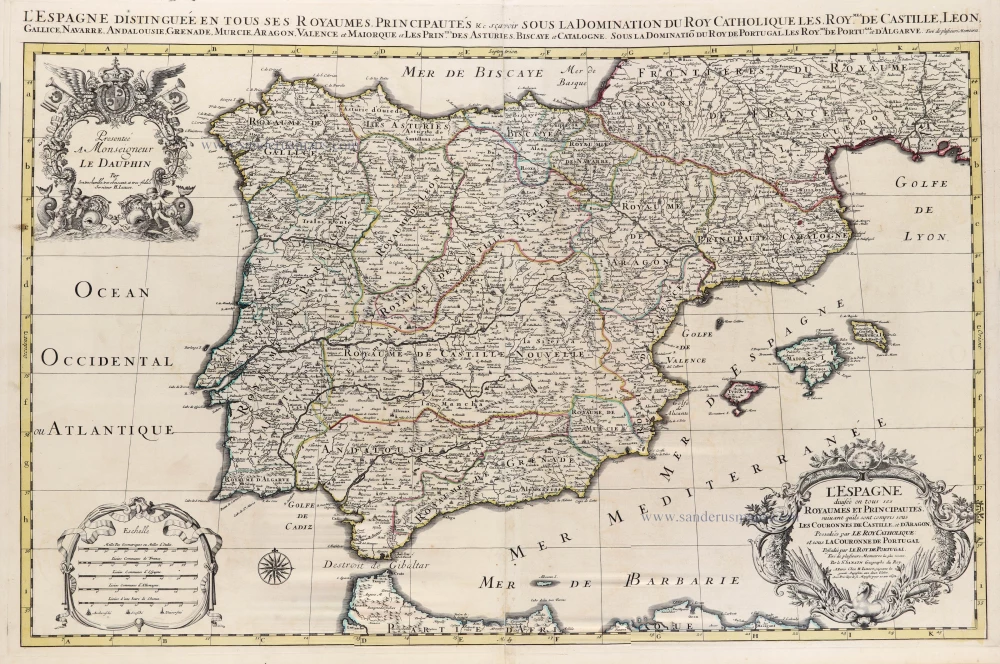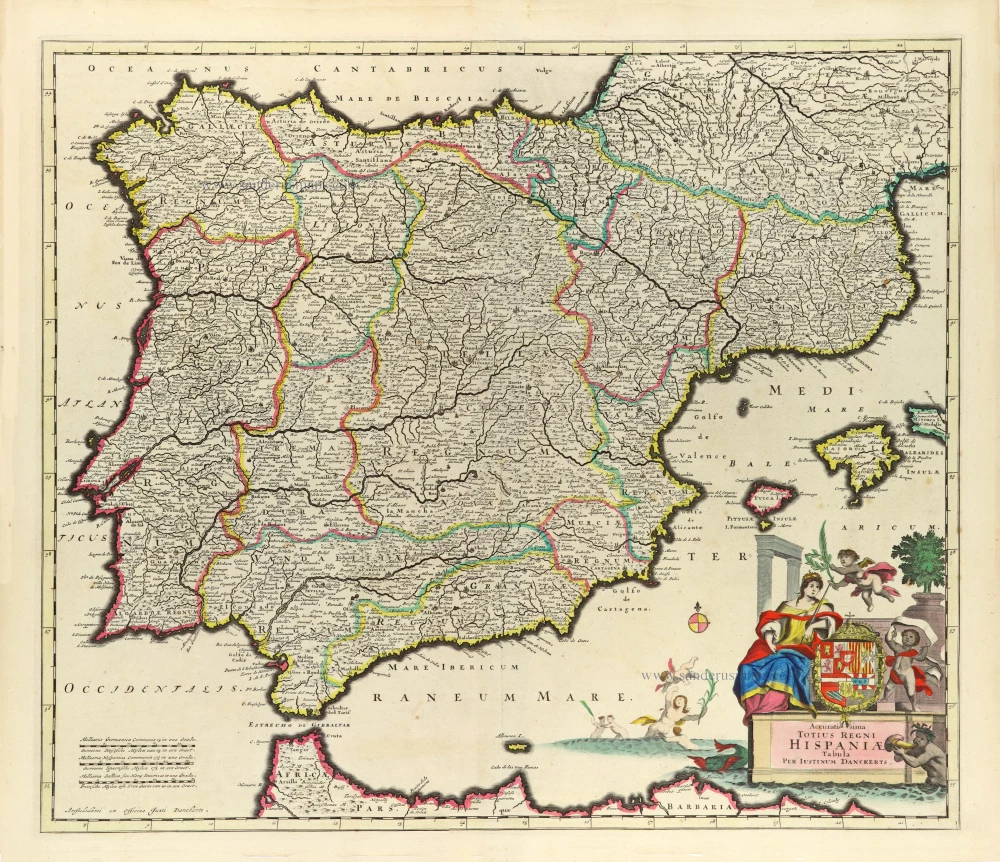Rare!
Spain by Willem Blaeu 1605
This map marks a new trend in illustrations on folio-sized maps. Blaeu's map of Holland (1604) was the first Dutch map to include a series of town views. On his map of Spain, a couple in national costume has been added to the decorative element. This couple and the depictions of Seville and Lisbon are found as well in the borders of Blaeu's double-hemisphere wall map of the world, which was also published in 1605.
The etcher used the town views by Braun & Hogenberg as a model for the four town views.
Blaeu's map is a compilation of two older works: Ortelius's Spain map of 1570 and the map engraved by Benjamin Wright and published by Cornelis Claesz around 1600.
A second state of this map appeared with the year 1605 removed.
The Blaeus: Willem Janszoon, Cornelis & Joan
Willem Jansz. Blaeu and his son Joan Blaeu are the seventeenth century's most widely known cartographic publishers.
Willem Jansz. (also written Guilielmus Janssonius) = Willem Janszoon Blaeu was born in Uitgeest (Netherlands), near Alkmaar, in 1571. He studied mathematics under Tycho Brahe and learned the theory and practice of astronomical observations and the art of instrument- and globe-making.
In 1596, he came to Amsterdam, where he settled down as a globe-, instrument- and mapmaker. He published his first cartographic work (a globe) in 1599 and probably published his first printed map (a map of the Netherlands) in 1604. He specialised in maritime cartography, published the first edition of the pilot guide Het Licht der Zeevaert in 1608, and was appointed Hydrographer of the V.O.C. (United East India Company) in 1633. After publishing books, wall maps, globes, charts and pilot guides for thirty years, he brought out his first atlas, Atlas Appendix (1630). This was the beginning of the great tradition of atlas-making by the Blaeus.
In 1618, another mapmaker, bookseller and publisher, Johannes Janssonius, established himself in Amsterdam next door to Blaeu's shop. No wonder these two neighbours began accusing each other of copying and stealing their information and became fierce competitors who did not have a good word to say about each other. In about 1621 Willem Jansz. decided to end the confusion between his name and his competitor's and assumed his grandfather's nickname, 'blauwe Willem' ('blue Willem'), as the family name; after that, he called himself Willem Jansz. Blaeu.
Willem Janszoon Blaeu died in 1638, leaving his prospering business to his sons, Cornelis and Joan. We only know that Cornelis's name occurs in the prefaces of books and atlases until c. 1645.
Joan Blaeu, born in Amsterdam in 1596, became a partner in his father's book trade and printing business. 1638, he was appointed his father's successor in the Hydrographic Office of the V.O.C. His efforts culminated in the magnificent Atlas Major and the town books of the Netherlands and Italy – works unsurpassed in history and modern times, giving eternal fame to the name of the Blaeu's.
A fire ruined the business on February 23, 1672, and one year later, Dr. Joan Blaeu died. The fire and the director's passing caused the complete sale of the Blaeu House's stock. Five public auctions dispersed the remaining books, atlases, copperplates, globes, etc., among many other map dealers and publishers in Amsterdam. The majority was acquired by several booksellers acting in partnership.
In the succeeding years, the remaining printing department remained in the hands of the Blaeu family until 1695, when the printing house's inventory was sold at a public auction. That meant the end of the Blaeu family as a printing house of world renown.
Nova Regni Hispaniae Descriptio, de novo multis in locis aucta et emendata.
Item Number: 28367 Authenticity Guarantee
Category: Antique maps > Europe > Spain and Portugal
Old, antique map of Spain & Portugal (Iberian Peninsula), by Willem Blaeu.
With four inset views in the corners: Toledo - Valladolid - Sevilla - Lisbona.
Title: Nova Regni Hispaniae Descriptio, de novo multis in locis aucta et emendata.
Amstelredami | Excudebat Guilielmus Janßonius
Anno 1605.
Date of the first edition: 1605.
Date of this map: 1605.
Date on map: 1605.
Copper engraving, printed on paper.
Map size: 400 x 540mm (15.75 x 21.26 inches).
Sheet size: 415 x 555mm (16.34 x 21.85 inches).
Verso: Blank.
Condition: Sharp impression, excellent.
Condition Rating: A+.
References: Van der Krogt 2, 6000:2A; Schilder 4, p. 39 9.1 & p. 162-168 Facs. 6
Separate publication.
This map marks a new trend in illustrations on folio-sized maps. Blaeu's map of Holland (1604) was the first Dutch map to include a series of town views. On his map of Spain, a couple in national costume has been added to the decorative element. This couple and the depictions of Seville and Lisbon are found as well in the borders of Blaeu's double-hemisphere wall map of the world, which was also published in 1605.
The etcher used the town views by Braun & Hogenberg as a model for the four town views.
Blaeu's map is a compilation of two older works: Ortelius's Spain map of 1570 and the map engraved by Benjamin Wright and published by Cornelis Claesz around 1600.
A second state of this map appeared with the year 1605 removed.
The Blaeus: Willem Janszoon, Cornelis & Joan
Willem Jansz. Blaeu and his son Joan Blaeu are the seventeenth century's most widely known cartographic publishers.
Willem Jansz. (also written Guilielmus Janssonius) = Willem Janszoon Blaeu was born in Uitgeest (Netherlands), near Alkmaar, in 1571. He studied mathematics under Tycho Brahe and learned the theory and practice of astronomical observations and the art of instrument- and globe-making.
In 1596, he came to Amsterdam, where he settled down as a globe-, instrument- and mapmaker. He published his first cartographic work (a globe) in 1599 and probably published his first printed map (a map of the Netherlands) in 1604. He specialised in maritime cartography, published the first edition of the pilot guide Het Licht der Zeevaert in 1608, and was appointed Hydrographer of the V.O.C. (United East India Company) in 1633. After publishing books, wall maps, globes, charts and pilot guides for thirty years, he brought out his first atlas, Atlas Appendix (1630). This was the beginning of the great tradition of atlas-making by the Blaeus.
In 1618, another mapmaker, bookseller and publisher, Johannes Janssonius, established himself in Amsterdam next door to Blaeu's shop. No wonder these two neighbours began accusing each other of copying and stealing their information and became fierce competitors who did not have a good word to say about each other. In about 1621 Willem Jansz. decided to end the confusion between his name and his competitor's and assumed his grandfather's nickname, 'blauwe Willem' ('blue Willem'), as the family name; after that, he called himself Willem Jansz. Blaeu.
Willem Janszoon Blaeu died in 1638, leaving his prospering business to his sons, Cornelis and Joan. We only know that Cornelis's name occurs in the prefaces of books and atlases until c. 1645.
Joan Blaeu, born in Amsterdam in 1596, became a partner in his father's book trade and printing business. 1638, he was appointed his father's successor in the Hydrographic Office of the V.O.C. His efforts culminated in the magnificent Atlas Major and the town books of the Netherlands and Italy – works unsurpassed in history and modern times, giving eternal fame to the name of the Blaeu's.
A fire ruined the business on February 23, 1672, and one year later, Dr. Joan Blaeu died. The fire and the director's passing caused the complete sale of the Blaeu House's stock. Five public auctions dispersed the remaining books, atlases, copperplates, globes, etc., among many other map dealers and publishers in Amsterdam. The majority was acquired by several booksellers acting in partnership.
In the succeeding years, the remaining printing department remained in the hands of the Blaeu family until 1695, when the printing house's inventory was sold at a public auction. That meant the end of the Blaeu family as a printing house of world renown.

